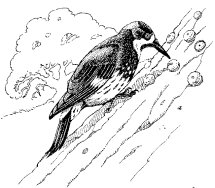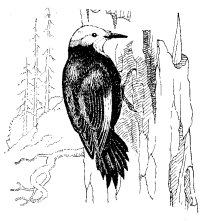
RED-SHAFTED FLICKER
| Online Library: | Title | Author | California | Geology | History | Indians | Muir | Mountaineering | Nature | Management |
Yosemite > Library > Birds of Yosemite > Woodpecker-like Birds >
Next: Perching Birds • Contents • Previous: Roller-like Birds
PILEATED WOODPECKER (Dryocopus pileatus): 17-18 in. Top of head including crest and bar on cheek bright red; red on head reduced and red cheek absent in female; white line above and below eye; long, wide stripe of white on neck; otherwise generally black except white patches in wings, more extensive on under side. Immature: Crest salmon. Feeds on beetle larvae, ants, and occasionally plant materials. Nests in dead conifers and large aspens.
Inhabits coniferous forests, especially of white and red firs and Douglas-fir. R. in the Yosemite region in the Transition and Canadian life zones. To be seen in Yosemite Valley at all seasons of the year.

RED-SHAFTED FLICKER |
Widespread R. in Yosemite region. In late summer and fall may be seen nearly to timberline. Observed at 10,200 feet near Parsons Peak.

ACORN WOODPECKER (Female) |
Frequents woodland areas chiefly in the Upper Sonoran life zone but also in the Transition life zone. Attracted to oak trees upon which it depends to a large extent for food and sites for nesting holes. Often stores acorns in dead trees, the bark of trees, fence posts, etc. Widespread common R. largely west of the Sierran divides, as at lower elevations in the Yosemite region. A conspicuous bird on the floor of Yosemite Valley where it is found associated with the black and canyon live oaks. Sometimes seen fly atching.

LEWIS’ WOODPECKER |
Erratic occurrence as R. from year to year. Frequents broken deciduous woodland or coniferous forest. Breeds chiefly in the Upper Sonoran and Transition life zones. Likely to be seen almost anywhere in the Yosemite region except in the denser forests. Has been seen at 9,500 feet above Ten Lakes.

YELLOW-BELLIED SAPSUCKER |
Red-breasted sapsucker, subspecies daggetti: Head, neck, and breast dark red; back black, mottled with white; distinctive white stripe along bend of wing, prominent even on immature birds which lack reddish of head and breast; white stripe from bill to under eyes.
Sapsuckers circle trunks and large branches of trees with small holes when foraging for sap and the tender growth layer (cambium) beneath the bark. They are especially fond of willows.
The red-naped sapsucker breeds in the northeastern part of California and winters in the south. Occasional W. V. to the Yosemite region. The red-breasted sapsucker breeds in northern California south through the Cascade-Sicrran mountain system to certain of the higher mountains of southern California, dispersing in winter to lower elevations. It is R. in the Transition and Canadian life zones in the Yosemite region. Seen in Yosemite Valley all year.

WILLIAMSON’S SAPSUCKER |
Breeds chiefly in the coniferous forests of the Canadian life zone. Often associated with lodgepole pine and red fir. Inhabits high mountains in summer and and slightly lower levels in winter. R. in the Canadian and Hudsonian life zones in the Yosemite region; occasional on the floor of Yosemite Valley in winter.

HAIRY WOODPECKER |
Frequents broken or open mixed deciduous and coniferous forest, especially where there are dead snags. R. in foothills and mountains. Breeds chiefly in the Transition and Canadian life zones. Widespread R. in the Yosemite region except in the Lower Sonoran life zone and above timberline.

NUTTALL’S WOODPECKER |
Often associated with oaks. R. chiefly in the Upper Sonoran life zone. Frequents foothills and canyons west of the Sierran crest. C. V. to lower elevations in the Yosemite region. Occasionally seen in Yosemite Valley.

WHITE-HEADED WOODPECKER |
R. in coniferous forests, chiefly in the Transition and lower Canadian life zones. Present in considerable numbers in the Yosemite region in the zones mentioned; common at Mariposa Grove, Glacier Point, and in Yosemite Valley.
BLACK-BACKED THREE-TOED WOODPECKER (Picoides arcticus): 9-10 in. Above black, except golden yellow on crown, wanting in female; wings barred with white spots; outer tail feathers white; black stripe from bill along side of head, bordered above by white line that passes below eye; under parts largely white; sides barred strongly with black; two toes in front, one behind (two toes behind in other woodpeckers in Yosemite region).
Usually associated with red fir, lodgepole pine, or hemlock. Found chiefly in the Canadian and Hudsonian life zones. Sparse R. in the Yosemite region. Observed near Mono Meadow, Siesta Lake, Tenaya Lake, Tuolumne Meadows, and McGee Lake at an altitude of 8,600 feet.
DOWNY WOODPECKER (Dendrocopos pubescens): 6-7 in. Resembles hairy woodpecker but much smaller and white outer tail feathers barred inconspicuously with black.
Frequents chiefly stream-border growth of willows, cottonwoods, and alders. In the Sierra Nevada it breeds most commonly in the Upper Sonoran and Transition life zones. R. in the Yosemite region up to an elevation of 5,750 feet, as on the Yosemite Falls Trail.
Next: Perching Birds • Contents • Previous: Roller-like Birds
| Online Library: | Title | Author | California | Geology | History | Indians | Muir | Mountaineering | Nature | Management |
http://www.yosemite.ca.us/library/birds_of_yosemite/woodpeckers.html